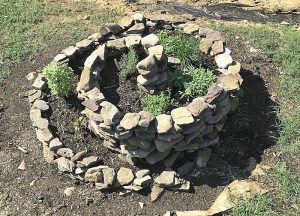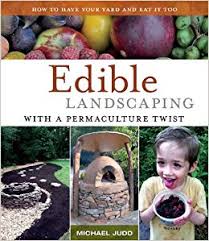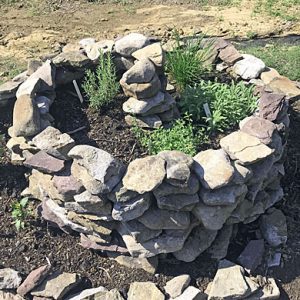Herb Spirals: A New Garden Feature to Love
By Marsha Goldberg, Fairfax Master Gardener
 Last spring, Fairfax County master gardeners were lucky enough to hear Michael Judd, author of Edible Landscaping with a Permaculture Twist, at their annual meeting. Among the ideas that Judd, who lives and works in Frederick, Maryland, discussed were herb spirals, small structures that he has been installing in gardens throughout the area. The spirals, usually made by stacking stones and filling them with dirt, rise in the middle, creating a perfect environment with excellent drainage for herbs. The placement of the herbs depends on their needs, with heat-loving Mediterranean herbs placed near the top where they can catch the sun and dry out, and hardier cold-tolerant herbs such as chives near the bottom.
Last spring, Fairfax County master gardeners were lucky enough to hear Michael Judd, author of Edible Landscaping with a Permaculture Twist, at their annual meeting. Among the ideas that Judd, who lives and works in Frederick, Maryland, discussed were herb spirals, small structures that he has been installing in gardens throughout the area. The spirals, usually made by stacking stones and filling them with dirt, rise in the middle, creating a perfect environment with excellent drainage for herbs. The placement of the herbs depends on their needs, with heat-loving Mediterranean herbs placed near the top where they can catch the sun and dry out, and hardier cold-tolerant herbs such as chives near the bottom.
Frankly, I filed the idea in my “maybe later” cache but coincidentally, when I reported for volunteer garden duty at Bailey’s Elementary School** (more about that later!), the garden manager told me that building an herb spiral was on her wish list.
“I can do that!” I said, happy to have a project. It took a few days to gather up the materials and lay it out but within two weeks we had a beautiful herb bed that far exceeded my expectations.

Michael Judd’s book
 I cleared the ground of weeds and plastic mulch. Once we were down to bare soil, I covered the area with cardboard, my go-to biodegradable first layer of mulch when I am starting a new bed. You could also use thick layers of newspaper. We then marked out a circle with a 6-foot diameter as a starting point. The size of the spiral can vary but we wanted it to be as big as possible while still being able to reach into the middle to plant, weed and harvest the herbs and we thought six feet would be about right. We then started laying out the stones in the spiral shape, raising it one layer every foot and a half per Judd’s instructions. The stones were heavy but the work went quickly and it was not hard to do (although I had a brawny instructional assistant doing most of the lifting for me!) And, luckily it was easy because I thought our first effort was too small but the second try seemed too big. We got it just right the third time although I can’t say what the final measurement was. I think 6 feet is a good starting point; it’s easy to adjust. Next, we filled the spiral with a mix of soil and compost we had on hand and finally added the herbs. Because it was near the end of the summer and we wanted to complete the project, I bought plants although I would typically start my herbs from seeds and cuttings. The plants came to about $40 but, again, this is a place where you could save money by starting them yourself.
I cleared the ground of weeds and plastic mulch. Once we were down to bare soil, I covered the area with cardboard, my go-to biodegradable first layer of mulch when I am starting a new bed. You could also use thick layers of newspaper. We then marked out a circle with a 6-foot diameter as a starting point. The size of the spiral can vary but we wanted it to be as big as possible while still being able to reach into the middle to plant, weed and harvest the herbs and we thought six feet would be about right. We then started laying out the stones in the spiral shape, raising it one layer every foot and a half per Judd’s instructions. The stones were heavy but the work went quickly and it was not hard to do (although I had a brawny instructional assistant doing most of the lifting for me!) And, luckily it was easy because I thought our first effort was too small but the second try seemed too big. We got it just right the third time although I can’t say what the final measurement was. I think 6 feet is a good starting point; it’s easy to adjust. Next, we filled the spiral with a mix of soil and compost we had on hand and finally added the herbs. Because it was near the end of the summer and we wanted to complete the project, I bought plants although I would typically start my herbs from seeds and cuttings. The plants came to about $40 but, again, this is a place where you could save money by starting them yourself.
The spiral is now complete, although you can see in the pictures that the area surrounding it still needs some work. I would like to add mulch around the perimeter or fill it in with some flowering plants. It looks beautiful despite that and the herbs have taken off like rockets in just a few weeks. Now, about that weedy mess and pile of bricks in my own garden…
**Bailey’s Elementary School occupies two sites in Fall Church, a lower school, where the garden is located, and an upper school. Please feel free to come and visit this lovely garden and see the herb spiral. The lower school has more than 700 students enrolled in grades K-2. Bailey’s Crossroads is the lowest income area in Fairfax County, so the school uses the garden not only to support the curriculum but also to provide free food for families and teach parents about gardening and nutrition. It’s a huge garden and we would love to have the help of other master gardeners. If you are interested in this rewarding volunteer opportunity, please message me through the Facebook page of Fairfax County Master Gardeners or, if you are a Fairfax County Master Gardener, find my information on the Sharepoint website.
Resource
Edible Landscaping with a Permaculture Twist, by Michael Judd